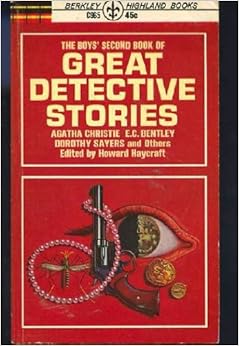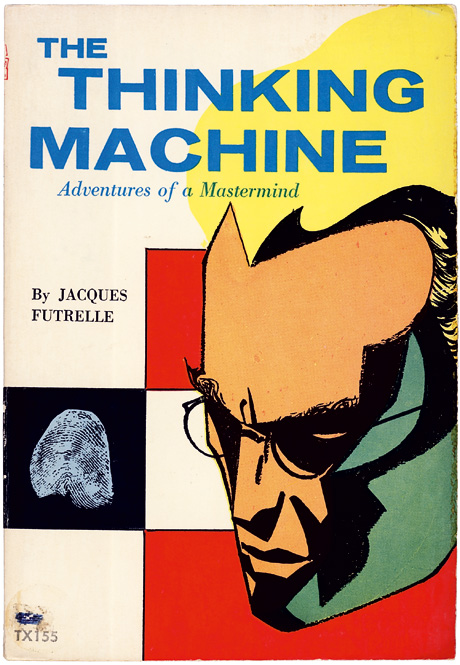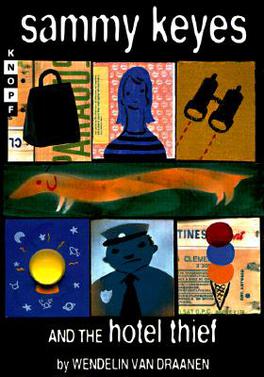Monday, June 30, 2014
Music Monday: MAP
The Music Alliance Pact (MAP) is an informal collection of indie music blogs, and every month they put out a list of song choices for the month. I came to to it via IndiefulROK and, if I have the time, give the tracks a listen-through and save the ones I like the best. I think "Paraquedas" from Russo Passapusso one may be my favorite out of the lot this month. It's got a very retro 70s funk beat.
Tuesday, June 24, 2014
Classics Club Question: Classics and Isms
Think of an example of a classic you’ve read that presents issues like racism/sexism as acceptable within society. Do you think the reception of this classic work would be the same if it were newly published today? What can we get out of this work despite its weaknesses? Or, why would you say this work is still respected/treasured/remembered in 2014?
Another Classics Club member (I wish I could remember which one! Please comment if it was you or you know who it was) mentioned Last of the Mohicans and went on to cite Cooper's weird romanticizing/fetishization of the American Indians*. I'm not saying it isn't there, and I'm not saying Twain's harsh criticism of Cooper isn't warranted (though that's style issues, not social justice), but it never took me out of the story. It was a product of its time, and in a lot of ways Cooper's treatment of American Indians is fairly progressive for its time (1826). I don't know what it is about Last of the Mohicans and Natty Bumppo but this might well be one of my favorite classics of all time. Even if it gets kind of secondhand embarrassing as time and tastes change.
The first book I thought of for this question, however, wasn't Last of the Mohicans. Like I said, Cooper's romanticization of the Delaware and 19th century views on gender relations never took me out of the story. What really made me uncomfortable was the anti-Semitism in John O'Hara's Appointment in Samarra.
The novel was not without controversy when it was first published; critics considered it vulgar and infantile. Many were put off by O'Hara's frank discussion of sexuality. Time has been kind to Appointment in Samarra in that regard, as those early concerns about its vulgarity vanished and the only thing that remains is its inclusion in the modern Western/English canon. Not without good reason: the book is otherwise masterfully plotted and written and O'Hara has some brilliant observations about the indeterminate nature of social relationships.
But in a novel that follows the inner life of everyone mentioned, including even the lone black character, the silence from the new Jewish residents of Gibbsville (small town USA based on the anthracite coal towns of northeastern Pennsylvania) is painful and conspicuous. It's one thing to write a book dealing with race and racism, or to have a racist character within a book that is not racist, but it's quite another to have contempt for a particular group of people go completely and totally unchecked in a book where every other prejudice and preconceived notion is examined and dismantled as necessary. The Jewish family doesn't figure much in the story—like I said, they don't get their own chapter or the same close third person narration that so many others do—and only a handful of characters even think about them at all. But every time they're mentioned, the revulsion is barely-contained and spans a variety of characters, even those we're supposed to like.
Such an attitude was probably okay in 1934. No one seemed to mention it in any of Appointment in Samarra's damning reviews. But I think if O'Hara were writing to day, those lines would meet with some heavy criticism—assuming they even made it to press. It's more likely that they would have been edited out of the manuscript very early on and never brought to the light of day.
Still, Appointment in Samarra is hardly an anti-Semitic propaganda piece. It is otherwise an enjoyable and insightful read, despite the introduction by one of my more loathed authors on the TIME Top 100 List, John Updike. The foibles of human interaction are something that will never change, even as customs and technology do, and that's what makes Appointment in Samarra universal.
*There are a whole host of names to refer to the civilizations that were already present in America when the Europeans started colonizing. I use the term "American Indian" to refer to them, at least in the United States, as it is the term a great majority of the peoples in question prefer for themselves. But if I'm wrong, let me know.
Another Classics Club member (I wish I could remember which one! Please comment if it was you or you know who it was) mentioned Last of the Mohicans and went on to cite Cooper's weird romanticizing/fetishization of the American Indians*. I'm not saying it isn't there, and I'm not saying Twain's harsh criticism of Cooper isn't warranted (though that's style issues, not social justice), but it never took me out of the story. It was a product of its time, and in a lot of ways Cooper's treatment of American Indians is fairly progressive for its time (1826). I don't know what it is about Last of the Mohicans and Natty Bumppo but this might well be one of my favorite classics of all time. Even if it gets kind of secondhand embarrassing as time and tastes change.
The first book I thought of for this question, however, wasn't Last of the Mohicans. Like I said, Cooper's romanticization of the Delaware and 19th century views on gender relations never took me out of the story. What really made me uncomfortable was the anti-Semitism in John O'Hara's Appointment in Samarra.
The novel was not without controversy when it was first published; critics considered it vulgar and infantile. Many were put off by O'Hara's frank discussion of sexuality. Time has been kind to Appointment in Samarra in that regard, as those early concerns about its vulgarity vanished and the only thing that remains is its inclusion in the modern Western/English canon. Not without good reason: the book is otherwise masterfully plotted and written and O'Hara has some brilliant observations about the indeterminate nature of social relationships.
But in a novel that follows the inner life of everyone mentioned, including even the lone black character, the silence from the new Jewish residents of Gibbsville (small town USA based on the anthracite coal towns of northeastern Pennsylvania) is painful and conspicuous. It's one thing to write a book dealing with race and racism, or to have a racist character within a book that is not racist, but it's quite another to have contempt for a particular group of people go completely and totally unchecked in a book where every other prejudice and preconceived notion is examined and dismantled as necessary. The Jewish family doesn't figure much in the story—like I said, they don't get their own chapter or the same close third person narration that so many others do—and only a handful of characters even think about them at all. But every time they're mentioned, the revulsion is barely-contained and spans a variety of characters, even those we're supposed to like.
Such an attitude was probably okay in 1934. No one seemed to mention it in any of Appointment in Samarra's damning reviews. But I think if O'Hara were writing to day, those lines would meet with some heavy criticism—assuming they even made it to press. It's more likely that they would have been edited out of the manuscript very early on and never brought to the light of day.
Still, Appointment in Samarra is hardly an anti-Semitic propaganda piece. It is otherwise an enjoyable and insightful read, despite the introduction by one of my more loathed authors on the TIME Top 100 List, John Updike. The foibles of human interaction are something that will never change, even as customs and technology do, and that's what makes Appointment in Samarra universal.
*There are a whole host of names to refer to the civilizations that were already present in America when the Europeans started colonizing. I use the term "American Indian" to refer to them, at least in the United States, as it is the term a great majority of the peoples in question prefer for themselves. But if I'm wrong, let me know.
Friday, June 20, 2014
The Classics Club
After I started following a few bookish blogs, I noticed a lot of the ones I particular liked linked to The Classics Club. I figured, since the TIME Top 100 Novels list is like a collection of modern classics, why not join?
The rules are simple: pick at least 50 classics (you can define what a classic is) and try to read them all in the next 5(ish) years. You can follow the link in the image above or in my sidebar for more information if you're interested.
I started attacking the TIME Top 100 list in earnest in around 2010 or so. Back then I had only read 25 of the books on it; right now I'm at 79. As I mentioned during ArmchairBEA, I've made some changes to it, but here's how it currently stands:
1. The Adventures of Augie March, Saul Bellow
2. All the King's Men, Robert Penn Warren
3. American Pastoral, Philip Roth
4. An American Tragedy, Theodore Dreiser
5. Animal Farm, George Orwell
6. Appointment in Samarra, John O'Hara
7. Are You There God? It's Me, Margaret, Judy Blume
8. The Assistant, Bernard Malamud
9. At Swim-Two-Birds, Flann O'Brien
10. Atonement, Ian McEwan
11. Beloved, Toni Morrison
12. The Berlin Stories, Christopher Isherwood
13. The Big Sleep, Raymond Chandler
14. The Handmaid's Tale, Margaret Atwood
15. Blood Meridian, Cormac McCarthy
16. Brideshead Revisited, Evelyn Waugh
17. The Bridge of San Luis Rey, Thornton Wilder
18. Call It Sleep, Henry Roth
19. Catch-22, Joseph Heller
20. The Catcher in the Rye, J.D. Salinger
17 / 20
21. A Clockwork Orange, Anthony Burgess
22. The Confessions of Nat Turner, William Styron
23. The Corrections, Jonathan Franzen
24. The Crying of Lot 49, Thomas Pynchon
25. Cry, the Beloved Country, Alan Patton
26. The Day of the Locust, Nathanael West
27. Death Comes for the Archbishop, Willa Cather
28. A Death in the Family, James Agee
29. The Death of the Heart, Elizabeth Bowen
30. Deliverance, James Dickey
31. Dog Soldiers, Robert Stone
32. Falconer, John Cheever
33. The French Lieutenant's Woman, John Fowles
34. Martha Quest, Doris Lessing
35. Go Tell it on the Mountain, James Baldwin
36. The Gravedigger's Daughter, Joyce Carol Oates
37. The Grapes of Wrath, John Steinbeck
38. Please Look After Mother, Shin Kyung-sook
39. The Great Gatsby, F. Scott Fitzgerald
40. The Jungle, Upton Sinclair
12 / 20
41. The Heart Is A Lonely Hunter, Carson McCullers
42. Native Speaker, Lee Chang-rae
43. The Namesake, Jhumpa Lahiri
44. Housekeeping, Marilynne Robinson
45. The Poisonwood Bible, Barbara Kingsolver
46. I, Claudius, Robert Graves
47. Infinite Jest, David Foster Wallace
48. Invisible Man, Ralph Ellison
49. Light in August, William Faulkner
50. The Lion, The Witch and the Wardrobe, C.S. Lewis
51. Lolita, Vladimir Nabokov
52. Lord of the Flies, William Golding
53. The Lord of the Rings, J.R.R. Tolkien
54. Kokoro, Soseki Natsumi
55. Lucky Jim, Kingsley Amis
56. The Man Who Loved Children, Christina Stead
57. Midnight's Children, Salman Rushdie
58. Money, Martin Amis
59. The Moviegoer, Walker Percy
60. Mrs. Dalloway, Virginia Woolf
17 / 20
61. Naked Lunch, William Burroughs
62. Name of the Rose, Umberto Eco
63. Native Son, Richard Wright
64. Neuromancer, William Gibson
65. Never Let Me Go, Kazuo Ishiguro
66. 1984, George Orwell
67. On the Road, Jack Kerouac
68. One Flew Over the Cuckoo's Nest, Ken Kesey
69. The Painted Bird, Jerzy Kosinski
70. The Buddha of Suburbia, Hanif Kureishi
71. A Passage to India, E.M. Forster
72. Play It As It Lays, Joan Didion
73. Farewell to Manzanar, Jeanne Wakatsuki Houston
74. Kafka on the Shore, Haruki Murakami
75. The Prime of Miss Jean Brodie, Muriel Spark
76. Rabbit, Run, John Updike
77. Ragtime, E.L. Doctorow
78. The Power and the Glory, Graham Greene
79. Red Harvest, Dashiell Hammett
80. Revolutionary Road, Richard Yates
15 / 20
81. The Sheltering Sky, Paul Bowles
82. Slaughterhouse-Five, Kurt Vonnegut
83. Snow Crash, Neal Stephenson
84. Possession, AS Byatt
85. The Good Earth, Pearl S. Buck
86. Your Republic is Calling You, Kim Young-ha
87. The Spy Who Came in From the Cold, John le Carre
88. The Sun Also Rises, Ernest Hemingway
89. Their Eyes Were Watching God, Zora Neale Hurston
90. Things Fall Apart, Chinua Achebe
91. To Kill a Mockingbird, Harper Lee
92. Sons and Lovers, D. H. Lawrence
93. Tropic of Cancer, Henry Miller
94. Ubik, Philip K. Dick
95. Under the Net, Iris Murdoch
96. Villa Incognito, Tom Robbins
97. Watchmen, Alan Moore & Dave Gibbons
98. White Noise, Don DeLillo
99. White Teeth, Zadie Smith
100. Wide Sargasso Sea, Jean Rhys
79 / 100
I still have some way to go, but I hope to be able to finish this list by the end of my 101 in 1001 list. I'm going to have to start thinking about what I want my next list of books to be: classics in languages besides English? Shakespeare's plays? Renaissance literature?
Any suggestions?
The rules are simple: pick at least 50 classics (you can define what a classic is) and try to read them all in the next 5(ish) years. You can follow the link in the image above or in my sidebar for more information if you're interested.
I started attacking the TIME Top 100 list in earnest in around 2010 or so. Back then I had only read 25 of the books on it; right now I'm at 79. As I mentioned during ArmchairBEA, I've made some changes to it, but here's how it currently stands:
4. An American Tragedy, Theodore Dreiser
6. Appointment in Samarra, John O'Hara
7. Are You There God? It's Me, Margaret, Judy Blume
8. The Assistant, Bernard Malamud
9. At Swim-Two-Birds, Flann O'Brien
10. Atonement, Ian McEwan
11. Beloved, Toni Morrison
12. The Berlin Stories, Christopher Isherwood
14. The Handmaid's Tale, Margaret Atwood
15. Blood Meridian, Cormac McCarthy
16. Brideshead Revisited, Evelyn Waugh
17. The Bridge of San Luis Rey, Thornton Wilder
18. Call It Sleep, Henry Roth
20. The Catcher in the Rye, J.D. Salinger
17 / 20
21. A Clockwork Orange, Anthony Burgess
23. The Corrections, Jonathan Franzen
24. The Crying of Lot 49, Thomas Pynchon
25. Cry, the Beloved Country, Alan Patton
26. The Day of the Locust, Nathanael West
28. A Death in the Family, James Agee
29. The Death of the Heart, Elizabeth Bowen
30. Deliverance, James Dickey
31. Dog Soldiers, Robert Stone
32. Falconer, John Cheever
33. The French Lieutenant's Woman, John Fowles
35. Go Tell it on the Mountain, James Baldwin
37. The Grapes of Wrath, John Steinbeck
38. Please Look After Mother, Shin Kyung-sook
39. The Great Gatsby, F. Scott Fitzgerald
40. The Jungle, Upton Sinclair
12 / 20
42. Native Speaker, Lee Chang-rae
43. The Namesake, Jhumpa Lahiri
44. Housekeeping, Marilynne Robinson
48. Invisible Man, Ralph Ellison
49. Light in August, William Faulkner
50. The Lion, The Witch and the Wardrobe, C.S. Lewis
51. Lolita, Vladimir Nabokov
52. Lord of the Flies, William Golding
53. The Lord of the Rings, J.R.R. Tolkien
54. Kokoro, Soseki Natsumi
55. Lucky Jim, Kingsley Amis
56. The Man Who Loved Children, Christina Stead
58. Money, Martin Amis
59. The Moviegoer, Walker Percy
17 / 20
62. Name of the Rose, Umberto Eco
63. Native Son, Richard Wright
65. Never Let Me Go, Kazuo Ishiguro
66. 1984, George Orwell
67. On the Road, Jack Kerouac
68. One Flew Over the Cuckoo's Nest, Ken Kesey
69. The Painted Bird, Jerzy Kosinski
70. The Buddha of Suburbia, Hanif Kureishi
72. Play It As It Lays, Joan Didion
73. Farewell to Manzanar, Jeanne Wakatsuki Houston
77. Ragtime, E.L. Doctorow
79. Red Harvest, Dashiell Hammett
15 / 20
82. Slaughterhouse-Five, Kurt Vonnegut
83. Snow Crash, Neal Stephenson
84. Possession, AS Byatt
86. Your Republic is Calling You, Kim Young-ha
87. The Spy Who Came in From the Cold, John le Carre
88. The Sun Also Rises, Ernest Hemingway
89. Their Eyes Were Watching God, Zora Neale Hurston
90. Things Fall Apart, Chinua Achebe
91. To Kill a Mockingbird, Harper Lee
92. Sons and Lovers, D. H. Lawrence
95. Under the Net, Iris Murdoch
96. Villa Incognito, Tom Robbins
97. Watchmen, Alan Moore & Dave Gibbons
98. White Noise, Don DeLillo
79 / 100
I still have some way to go, but I hope to be able to finish this list by the end of my 101 in 1001 list. I'm going to have to start thinking about what I want my next list of books to be: classics in languages besides English? Shakespeare's plays? Renaissance literature?
Any suggestions?
Thursday, June 19, 2014
Trek Thursdsay: Catspaw
#63. Catspaw
In case you forgot: It's a very special Halloween episode of Star Trek!
I guess there's some camp value in how goofy this episode is. Upon review of my original list, I actually bumped this up a few places (originally it was at #73), when I decided I'd rather watch this one again than some others I originally listed before it.
But when you take away the goofy occult theatrics (is Korob supposed to be a reference to Anton Szandor LaVey?) it's just not a particularly interesting or thoughtful story. There's no great moral dilemma or commentary on the human condition. Just the power trio versus a couple of wizards.
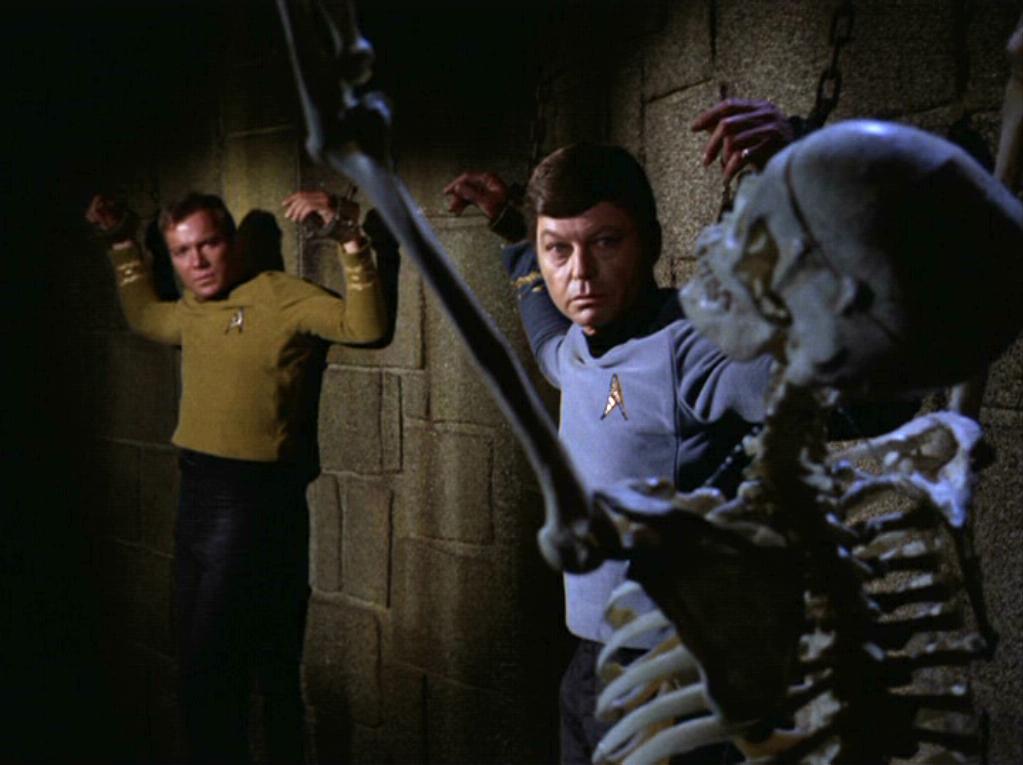 |
| Kirk, McCoy, and Bones. Har har. |
I guess there's some camp value in how goofy this episode is. Upon review of my original list, I actually bumped this up a few places (originally it was at #73), when I decided I'd rather watch this one again than some others I originally listed before it.
But when you take away the goofy occult theatrics (is Korob supposed to be a reference to Anton Szandor LaVey?) it's just not a particularly interesting or thoughtful story. There's no great moral dilemma or commentary on the human condition. Just the power trio versus a couple of wizards.
Wednesday, June 18, 2014
What I Read: Tropic of Cancer
I confess to not knowing a whole lot about Tropic of Cancer before I started reading it, except of the infamous smut charges brought against it back in the day. Speaking of smut, let's have a Tom Lehrer aside:
Stockholm Stadsbiblioteket even classifies this as "erotic." Which is great, there's nothing I love more than walking out of the library with a book that says EROTISK in big, bold letters on the spine. This is the same category with 50 Shades of Grey and all of its derivatives, by the way. just to give you an idea of how what this library system considers erotic. Suffice it to say, between that and the obscenity charges I was expecting one thing, and very much got something else. Miller talks very frankly about sex, and the human anatomy, and particularly the female anatomy, but it's about as erotic or as obscene as an edition of Grey's Anatomy. I suspect it was his gratuitous use of the word "cunt" that got him in trouble more than anything else; the vast majority of the book has little to do with sex and much to do with the expat identity (whatever that means) and being an American in Paris. Time for another musical interlude:
This one was a tough nut for me to crack. It starts out quite concretely ("I am living in the Villa Borghese. There is not a crumb of dirt anywhere, nor a chair misplaced. We are all alone here and we are dead.") and then suddenly and without warning slips into quite another mood altogether, stream of consciousness and surreal and addressing characters we never get to know:
Beyond expatriation, reading books like Tropic of Cancer makes me wonder: what would I do if one of my friends churned out a high literary masterpiece right under my nose? If this hadn't been a bound and finished and lauded as a modern classic, what would I have thought about it? What changes would I have marked, what passages would I have cut? Tough questions I can't answer. But this is the first book in a while that has been eminently quotable. You may find that most of them are sentiments that could be expressed about being an American expat in South Korea. Replace "Europe" and "France" accordingly.
Dozing off. The physiology of love. The whale with his six-foot penis, in repose. The bat—penis libre. Animals with a bone in the penis. Hence, a bone on...."Happily," says Gourmont, "the bony structure is lost in man." Happily? Yes, happily. Think of the human race walking around with a bone on. The kangaroo has a double penis—one for weekdays and one for holidays. Dozing. A letter from a female asking if I have found a title for my book. Title? To be sure: "Lovely Lesbians."
Your anecdotal life! A phrase of M. Borowski's...That shift was hard for me to take, but once I adjusted my expectations it was a compelling read. The expat genre, if it can be termed that, seems to be my favorite genre of the TIME Top 100 list. Having lived and worked in South Korea (which, I am convinced, would have generated a second Lost Generation's worth of art and literature if not for the immediate gratification of blogging) and moved to Sweden, novels about Americans abroad are certainly relevant to my life experiences.
Beyond expatriation, reading books like Tropic of Cancer makes me wonder: what would I do if one of my friends churned out a high literary masterpiece right under my nose? If this hadn't been a bound and finished and lauded as a modern classic, what would I have thought about it? What changes would I have marked, what passages would I have cut? Tough questions I can't answer. But this is the first book in a while that has been eminently quotable. You may find that most of them are sentiments that could be expressed about being an American expat in South Korea. Replace "Europe" and "France" accordingly.
In Europe one gets used to doing nothing. You sit on your ass and whine all day. You get contaminated. You rot.
The book must be absolutely original, absolutely perfect. That is why, among other things, it is impossible for him to get started on it. As soon as he gets an idea he begins to question it. He remembers that Dostoevski used it, or Hamsun, or somebody else. "I'm not saying that I want to be better than them, but I want to be different," he explains. And so, instead of tackling his book, he reads one author after another in order to make absolutely certain that he is not going to tread on their private property. And the more he reads the more disdainful he becomes. None of them are satisfying; none of them arrive at that degree of perfection which he has imposed upon himself. And forgetting completely that he has not written as much as a chapter he talks about them condescendingly, quite as though there existed a shelf of books bearing his name, books which everyone is familiar with and the titles of which it is therefore superfluous to mention.
That this sort of thing existed I knew, but then one also knows that there are slaughterhouses and morgues and dissecting rooms. One instinctively avoids such places. In the street I had often passed a priest with a little prayer book in his hands laboriously memorizing his lines. Idiot, I would say to myself, and let it go at that. In the street one meets with all forms of dementia and the priest is by no means the most striking. Two thousand years of it has deadened us to the idiocy of it. However, when you are suddenly transported to the very midst of his realm, when you see the little world in which the priest functions like an alarm clock, you are apt to have entirely different sensations.
"...I was born in New England and I belong there, I guess. You can't become a European overnight. There's something in your blood that makes you different. It's the climate—and everything. We see things with different eyes. We can't make ourselves over, however much we admire the French. We're Americans and we've got to remain Americans. Sure, I hate those puritanical buggers back home—I hate 'em with all my guts. But I'm one of them myself. I don't belong here. I'm sick of it."
All along the arcade he went on like this. I wasn't saying a word. I let him spill it all out—it was good for him to get it off his chest. Just the same, I was thinking how strange it was that this same guy, had it been a year ago, would have been beating his chest like a gorilla and saying: "What a marvelous day! What a country! What a people!" And if an American had happened along and said one word against France Fillmore would have flattened his nose. He would have died for France—a year ago. I never saw a man who was so infatuated with a country, who was so happy under a foreign sky. It wasn't natural. When he said France it meant wine, women, money in the pocket, easy come, easy go. It meant being a bad boy, being on a holiday. And then, when he had had his fling, when the tent top blew off and he had a good look at the sky, he saw that it wasn't just a circus, but an arena, just like everywhere. And a damned grim one. I often used to think, when I heard him rave about glorious France, about liberty and all that crap, what it would have sounded like to a French workman, could he have understood Fillmore's words. No wonder they think we're all crazy. We are crazy to them. We're just a pack of children. Senile idiots. What we call life is a five-and-ten-cent store romance. That enthusiasm underneath—what is it? That cheap optimism which turns the stomach of any ordinary European? It's illusion. No, illusion's to good a word for it. Illusion means something. No, it's not that—it's delusion. It's sheer delusion, that's what. We're like a herd of wild horses with blinders over our eyes.By the time this post goes up, I'll have returned this to the library. I don't know if I'll buy a copy for myself eventually, but I know at one point I'll need to re-read it. After I have time to digest and think on it a while.
Friday, June 13, 2014
What I'm Playing: Ni No Kuni
As you can surmise from my participation in ArmchairBEA, I spend a lot of time reading. To a lesser, but still significant. extent, I spend a lot of time playing video games. They are one of my geeky loves and if I'm going to share my love of books here, why not my love of video games?
JV combed through his PS3 collection the other day and a generous third (or a skimpy half) of his collection was deemed "unworthy." We schlepped them all over to GameStop and with the store credit from those he bought three new games, including Ni No Kuni.
I had first heard of Ni No Kuni from an acquaintance of mine back home and it piqued my interest right away, because it was developed by Level 5 and Studio Ghibli. Yes, Studio Ghibli! Two things I love, together at last!
I'm not sure how much input Studio Ghibli had with the game itself, or whether they were just consulted with for character design, or art, or just the cut scenes. Level 5 developed the Professor Layton series for the Nintendo DS, so they're no strangers to the ~kawaii~~~ market. I'll only say that there's nothing in this game, from the art to the story to the character design, that would be out of place in a Studio Ghibli movie.
That is to say, the game is basically made of cute (and magic). It's a breath of fresh air in video game trends.
You play as Oliver, or Ollie, a young boy transported to another, magical world. There's a big bad evil threatening the land and breaking people's hearts, and a fairy with a lantern nose ring thinks that you're the Chosen One.
The mechanics are firmly rooted within the tradition of JRPGs, so none of it will take you by too much surprise if you've spent a lot of time with Pokémon or the Final Fantasy series. You kill baddies and level up, and as you progress through the game you'll learn spells to use in and out of combat.
One of the earliest spells you learn is how to create a familiar. A familiar is basically like a Pokémonc crossed with a Tamagotchi: it gains experience from combat and learns skills as it levels up, but you can also improve it by feeding it treats. Different treats will improve different stats, and you can only feed it so much.
A familiar can fight in combat for you, and you can control it directly—it isn't operated by AI or anything like that. In fights, your familiar uses your HP and MP, but it has its own stamina gauge. When it runs out of stamina, it can't fight anymore, even if you have full health. Regardless of who fights, every encounter awards experience to you and your familiar like (so you don't have to include it in combat to get experience, like you do in Pokémon).
The combat system works well enough. Generally I'm not a fan of the tactical, turn-taking combat like in Final Fantasy Tactics, Baldur's Gate, or Knights of the Old Republic, and Ni No Kuri avoids that model. There is definitely an element of timing and turn-taking, so it isn't a totally realtime beat 'em up hack 'n slash, but it's all very fluid and flows well. You can cancel an action at any time, and if you're not in the middle of an action you're free to move around the battle area as much as you like. Which is handy because enemies often drop free HP and MP recovers. My only gripe is that it can be difficult to switch out of characters or to switch spells in a pinch: you move with the L joystick but use the D-pad to choose among Oliver and his familiars, or among your current character's skills. That makes trying to evade hits while switching to anything besides "Attack" incredibly awkward because it's all happening on the left hand side of the controller.
Outside of combat, there is a lot going on in the game: you have spells to learn, you have to manage your HP and MP, you have your familiars to tend to, you have your party members to tend to, you have hearts to mend, you have do-gooder quests and monster hunts to complete, and probably more that I haven't encountered yet in four hours of play. It seems like a lot at the beginning, especially for something that looks so light and cute, but the game does a good job of walking you through things and getting you used to everything.
I'm not very far in, so I can't comment on the characters or the story or so on, but really, Ni No Kuni is such a striking, unique game that I wanted to share my thoughts on it right away. I don't expect to be disappointed in the story—I trust that Studio Ghibli wouldn't have gotten involved if they couldn't have some say in that, after all—but we shall see.
Ni No Kuni is available on the Nintendo DS and the PlayStation 3. I'm playing it on the PS3; I think on the DS there are neat little motion elements with the spells (similar to Ookami) but otherwise they're not too different, I don't think. If you haven't played it already, I highly recommend it.
JV combed through his PS3 collection the other day and a generous third (or a skimpy half) of his collection was deemed "unworthy." We schlepped them all over to GameStop and with the store credit from those he bought three new games, including Ni No Kuni.
I had first heard of Ni No Kuni from an acquaintance of mine back home and it piqued my interest right away, because it was developed by Level 5 and Studio Ghibli. Yes, Studio Ghibli! Two things I love, together at last!
I'm not sure how much input Studio Ghibli had with the game itself, or whether they were just consulted with for character design, or art, or just the cut scenes. Level 5 developed the Professor Layton series for the Nintendo DS, so they're no strangers to the ~kawaii~~~ market. I'll only say that there's nothing in this game, from the art to the story to the character design, that would be out of place in a Studio Ghibli movie.
That is to say, the game is basically made of cute (and magic). It's a breath of fresh air in video game trends.
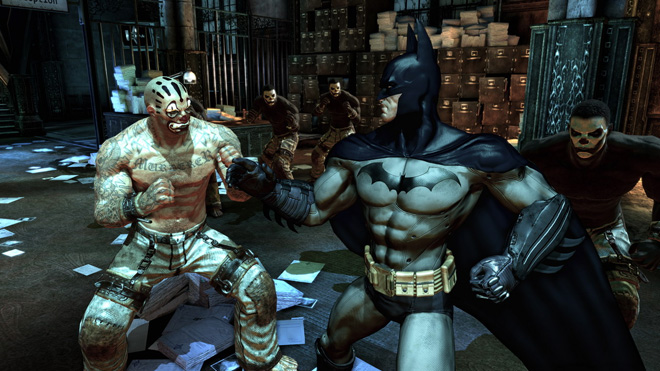 |
| Which isn't to say that a gritty, dirty, "realistic" game can't be good, mind you. |
 |
| But sometimes I just need something cute. |
The mechanics are firmly rooted within the tradition of JRPGs, so none of it will take you by too much surprise if you've spent a lot of time with Pokémon or the Final Fantasy series. You kill baddies and level up, and as you progress through the game you'll learn spells to use in and out of combat.
One of the earliest spells you learn is how to create a familiar. A familiar is basically like a Pokémonc crossed with a Tamagotchi: it gains experience from combat and learns skills as it levels up, but you can also improve it by feeding it treats. Different treats will improve different stats, and you can only feed it so much.
A familiar can fight in combat for you, and you can control it directly—it isn't operated by AI or anything like that. In fights, your familiar uses your HP and MP, but it has its own stamina gauge. When it runs out of stamina, it can't fight anymore, even if you have full health. Regardless of who fights, every encounter awards experience to you and your familiar like (so you don't have to include it in combat to get experience, like you do in Pokémon).
The combat system works well enough. Generally I'm not a fan of the tactical, turn-taking combat like in Final Fantasy Tactics, Baldur's Gate, or Knights of the Old Republic, and Ni No Kuri avoids that model. There is definitely an element of timing and turn-taking, so it isn't a totally realtime beat 'em up hack 'n slash, but it's all very fluid and flows well. You can cancel an action at any time, and if you're not in the middle of an action you're free to move around the battle area as much as you like. Which is handy because enemies often drop free HP and MP recovers. My only gripe is that it can be difficult to switch out of characters or to switch spells in a pinch: you move with the L joystick but use the D-pad to choose among Oliver and his familiars, or among your current character's skills. That makes trying to evade hits while switching to anything besides "Attack" incredibly awkward because it's all happening on the left hand side of the controller.
Outside of combat, there is a lot going on in the game: you have spells to learn, you have to manage your HP and MP, you have your familiars to tend to, you have your party members to tend to, you have hearts to mend, you have do-gooder quests and monster hunts to complete, and probably more that I haven't encountered yet in four hours of play. It seems like a lot at the beginning, especially for something that looks so light and cute, but the game does a good job of walking you through things and getting you used to everything.
I'm not very far in, so I can't comment on the characters or the story or so on, but really, Ni No Kuni is such a striking, unique game that I wanted to share my thoughts on it right away. I don't expect to be disappointed in the story—I trust that Studio Ghibli wouldn't have gotten involved if they couldn't have some say in that, after all—but we shall see.
Ni No Kuni is available on the Nintendo DS and the PlayStation 3. I'm playing it on the PS3; I think on the DS there are neat little motion elements with the spells (similar to Ookami) but otherwise they're not too different, I don't think. If you haven't played it already, I highly recommend it.
Thursday, June 12, 2014
Trek Thursday: The City on the Edge of Forever
#64. The City on the Edge of Forever
In case you forgot: McCoy accidentally travels back to the 1930s and messes up the timeline. Kirk and Spock have to go retrieve him.
Yeah, that's right: The City on the Edge of Forever is a crappy Star Trek episode. Come at me, Trekkies.
There might be a small contingent of fans who agree with me out of a die-hard devotion to Harlan Ellison; his spite over script changes and disdain for the resulting episode is legendary. Unfortunately, that's not my beef with this episode. Everything wrong with it is something that Harlan (as far as I know) penned himself.
This episode is often billed as Kirk's encounter with "the one woman" and the defenses of City's greatness are based on this same assertion, but I don't buy it. The romance between Kirk and Edith falls flat when you consider that before, and after, Kirk romanced every green-skinned space babe the Enterprise encountered.
Not to mention: how can any kind of great love bloom between them over the course of a week? It would be a stretch in most cases, but Kirk has not once indicated that he is capable of forming a meaningful romantic bond with a woman outside of the little in-and-out. Honestly, I could swallow Kirk and Miramanee as a couple more easily than I could swallow Kirk and Edith. At least he got the courtesy of a couple of months with Miramanee, even knocking her up.
Okay, well, then the tragedy is that a good woman has to die for things to be set aright! How sad. But that happens in other episodes, too. Nothing in this episode is unique and never done before (or again), or done particularly well. How it won awards—a Hugo, a Writers Guild of America teleplay award—will always be beyond my understanding.
In case you forgot: McCoy accidentally travels back to the 1930s and messes up the timeline. Kirk and Spock have to go retrieve him.
Yeah, that's right: The City on the Edge of Forever is a crappy Star Trek episode. Come at me, Trekkies.
There might be a small contingent of fans who agree with me out of a die-hard devotion to Harlan Ellison; his spite over script changes and disdain for the resulting episode is legendary. Unfortunately, that's not my beef with this episode. Everything wrong with it is something that Harlan (as far as I know) penned himself.
 |
| The red-hot passion! |
This episode is often billed as Kirk's encounter with "the one woman" and the defenses of City's greatness are based on this same assertion, but I don't buy it. The romance between Kirk and Edith falls flat when you consider that before, and after, Kirk romanced every green-skinned space babe the Enterprise encountered.
Not to mention: how can any kind of great love bloom between them over the course of a week? It would be a stretch in most cases, but Kirk has not once indicated that he is capable of forming a meaningful romantic bond with a woman outside of the little in-and-out. Honestly, I could swallow Kirk and Miramanee as a couple more easily than I could swallow Kirk and Edith. At least he got the courtesy of a couple of months with Miramanee, even knocking her up.
Okay, well, then the tragedy is that a good woman has to die for things to be set aright! How sad. But that happens in other episodes, too. Nothing in this episode is unique and never done before (or again), or done particularly well. How it won awards—a Hugo, a Writers Guild of America teleplay award—will always be beyond my understanding.
Wednesday, June 11, 2014
What I Read: White Teeth
Playing hostess last week offered me a surprising amount of time to catch up on my reading, so I managed to polish off Zadie Smith's White Teeth, a selection from my altered TIME Top 100 Novels list.
The scope of White Teeth is impressive. Smith traces the stories of Archie Jones, Samar Iqbal, and their respective families from Jones and Iqbal's service during World War II to their children's chaotic and tumultuous teenage years. Smith handles it all deftly, sketching particular moments with such detail and insight that no further history is needed. Multiple characters and story arcs are expertly woven together, culminating in the book's madcap WonderMouse debut climax.
Other readers have commented that the characters lacked depth or relatability—that they were amusing and funny, but didn't really inspire empathy or an investment in their success. I don't think this is the case, but I think the ultimately humorous, light-hearted tone of Smith's writing can trick you into thinking that White Teeth isn't a "serious" novel. What was a letdown for me was the end; it lacked a lot of really good closure. I don't want to go into much detail since it's a fairly spoilable one. It was just more open-ended than I was expecting.
The scope of White Teeth is impressive. Smith traces the stories of Archie Jones, Samar Iqbal, and their respective families from Jones and Iqbal's service during World War II to their children's chaotic and tumultuous teenage years. Smith handles it all deftly, sketching particular moments with such detail and insight that no further history is needed. Multiple characters and story arcs are expertly woven together, culminating in the book's madcap WonderMouse debut climax.
Other readers have commented that the characters lacked depth or relatability—that they were amusing and funny, but didn't really inspire empathy or an investment in their success. I don't think this is the case, but I think the ultimately humorous, light-hearted tone of Smith's writing can trick you into thinking that White Teeth isn't a "serious" novel. What was a letdown for me was the end; it lacked a lot of really good closure. I don't want to go into much detail since it's a fairly spoilable one. It was just more open-ended than I was expecting.
Tuesday, June 10, 2014
On The Turing Test and AI
The news about yet another chatbot "passing" the Turing Test has been all over my news feed. It seems that few of the people writing on Eugene Goostman, the chatbot posing as a 13 year old boy from eastern Europe, have actually read the paper in question or have any kind of nuanced understanding of what the Turing Test entails. PZ Myers has summed up everything wrong with the reporting quite nicely. I just wanted to talk a little bit about something near and dear to my heart: the Turing Test.
The Turing Test, for those of you unfamiliar with the original source material, was originally proposed by computing genius and visionary Alan Turing, whose homosexuality was more important to the authorities of Great Britain than the fact that he was an instrumental member in the think tank that ultimately outwitted the Germans' Enigma machine. Oop.
It appeared in a longer piece called "Computing machinery and intelligence," published in Mind magazine in 1950. There is a lot of interesting stuff in there, and if you're at all interested in computer science....well, honestly, you've probably read it already, but there it is in case you haven't.
The Turing Test, Defined More Clearly
As an introduction to his proposal, Turing initially describes an imitation game played with three people: a man (A), a woman (B), and a judge (whose sex is irrelevant) (C). The goal is for the judge to correctly identify which player is the man and which the woman. There is, of course, a series of questions and answers involved, but it isn't the kind of interviewing that has been accepted as the Turing Test standard:
Then he proposes that the same game be played, only this time with a human and machine trying to fool the judge, instead of two humans.There is a level of trickery and strategy involved with the background of the Turing Test (what he calls "the imitation game"; Turing wasn't vain enough to name the test after himself in his own paper). It's not merely a conversation with ELIZA.
And while it seems like a very limited situation—a judge just getting written or secondhand feedback from players confined to different rooms—that's really just Turing trying to make the game as fair as possible, so that the machine could be judged on its cognition alone.
To limit the idea of the Turing Test to a reiteration of the imitation game (even the more complex, deceit-filled model of the imitation game as described above) is missing Turing's larger point: can machines demonstrate the same behaviors that we associate with thinking and intelligence?
Polishing the Turing Test
Unsurprisingly, chatbots have been the favored method of would-be Turing Test passers, since the medium of instant messaging is basically identical to Turing's hypothetical setup. But daily life is mediated by computers and technology in ways that were probably unthinkable even to a visionary such as Turing. If he were writing "Computing machinery and intelligence" today, he'd perhaps make Facebook, Twitter, or Tumblr (ugh) the means of his contest. Surely it's not impossible to conceive of an AI that would post to social media (maybe even on multiple accounts), sharing thoughts and articles and quiz results and interacting with its followers the same way that people do. Some of the people who post in your news feed might already seem like thoughtless automatons.
The other problem with chatbots as Turing Test experiments is that it misses the spirit of the Test. Programming an AI only to pass the Turing Test and nothing more doesn't a thinking machine make. However, that doesn't mean the Turing Test is bullshit, or isn't a useful tool for evaluating AI, either. If you take something like Siri, for example, or Samantha from Her, which are programmed to do quite a number of tasks, we'd say they were "thinking" if they passed the Turing Test incidentally. Turing never mentions this incidental nature of the test but it seems an intuitively important part of the test. When you consider how much of human cognition and intelligence is incidental to our brains and the problems they evolved to solve, this seems only fair. Or, as Harnad suggests, the Turing Test isn't something that should last for five minutes or fifteen or an hour, but indefinitely.
Objections to the Turing Test
Humans tend to assume that everyone else we come into contact with are human too, or are at least human-like. Which is why you get vegans assuming their cats should also be on a vegan diet, for example: we are biased towards believing things more or less "like us" and generally it takes more proof to disprove rather than prove. The Turing Test may, in fact, be too simple to be a good criterion.
There's also Searle's Chinese Room objection. I've never much cared for it or thought it to be a particularly strong objection, but it's a famous one nonetheless.
TL;DR
The AI singularity is not yet upon us and we will not be bowing before our robot overlord Eugeene Goostman. Goostman, really, could hardly be said to have "passed" the test; whether or not this implementation of the Turing Test even adheres to Turing's original vision is another question altogether.
The Turing Test, for those of you unfamiliar with the original source material, was originally proposed by computing genius and visionary Alan Turing, whose homosexuality was more important to the authorities of Great Britain than the fact that he was an instrumental member in the think tank that ultimately outwitted the Germans' Enigma machine. Oop.
It appeared in a longer piece called "Computing machinery and intelligence," published in Mind magazine in 1950. There is a lot of interesting stuff in there, and if you're at all interested in computer science....well, honestly, you've probably read it already, but there it is in case you haven't.
The Turing Test, Defined More Clearly
As an introduction to his proposal, Turing initially describes an imitation game played with three people: a man (A), a woman (B), and a judge (whose sex is irrelevant) (C). The goal is for the judge to correctly identify which player is the man and which the woman. There is, of course, a series of questions and answers involved, but it isn't the kind of interviewing that has been accepted as the Turing Test standard:
C: Will X please tell me the length of his or her hair?Now suppose X is actually A, then A must answer. It is A's object in the game to try and cause C to make the wrong identification. His answer might therefore be:"My hair is shingled, and the longest strands are about nine inches long."In order that tones of voice may not help the interrogator the answers should be written, or better still, typewritten. The ideal arrangement is to have a teleprinter communicating between the two rooms. Alternatively the question and answers can be repeated by an intermediary. The object of the game for the third player (B) is to help the interrogator. The best strategy for her is probably to give truthful answers. She can add such things as "I am the woman, don't listen to him!" to her answers, but it will avail nothing as the man can make similar remarks.We now ask the question, "What will happen when a machine takes the part of A in this game?" Will the interrogator decide wrongly as often when the game is played like this as he does when the game is played between a man and a woman? These questions replace our original, "Can machines think?"
Then he proposes that the same game be played, only this time with a human and machine trying to fool the judge, instead of two humans.There is a level of trickery and strategy involved with the background of the Turing Test (what he calls "the imitation game"; Turing wasn't vain enough to name the test after himself in his own paper). It's not merely a conversation with ELIZA.
And while it seems like a very limited situation—a judge just getting written or secondhand feedback from players confined to different rooms—that's really just Turing trying to make the game as fair as possible, so that the machine could be judged on its cognition alone.
The question and answer method seems to be suitable for introducing almost any one of the fields of human endeavour that we wish to include. We do not wish to penalise the machine for its inability to shine in beauty competitions, nor to penalise a man for losing in a race against an aeroplane. The conditions of our game make these disabilities irrelevant. The "witnesses" can brag, if they consider it advisable, as much as they please about their charms, strength or heroism, but the interrogator cannot demand practical demonstrations.
To limit the idea of the Turing Test to a reiteration of the imitation game (even the more complex, deceit-filled model of the imitation game as described above) is missing Turing's larger point: can machines demonstrate the same behaviors that we associate with thinking and intelligence?
Polishing the Turing Test
Unsurprisingly, chatbots have been the favored method of would-be Turing Test passers, since the medium of instant messaging is basically identical to Turing's hypothetical setup. But daily life is mediated by computers and technology in ways that were probably unthinkable even to a visionary such as Turing. If he were writing "Computing machinery and intelligence" today, he'd perhaps make Facebook, Twitter, or Tumblr (ugh) the means of his contest. Surely it's not impossible to conceive of an AI that would post to social media (maybe even on multiple accounts), sharing thoughts and articles and quiz results and interacting with its followers the same way that people do. Some of the people who post in your news feed might already seem like thoughtless automatons.
The other problem with chatbots as Turing Test experiments is that it misses the spirit of the Test. Programming an AI only to pass the Turing Test and nothing more doesn't a thinking machine make. However, that doesn't mean the Turing Test is bullshit, or isn't a useful tool for evaluating AI, either. If you take something like Siri, for example, or Samantha from Her, which are programmed to do quite a number of tasks, we'd say they were "thinking" if they passed the Turing Test incidentally. Turing never mentions this incidental nature of the test but it seems an intuitively important part of the test. When you consider how much of human cognition and intelligence is incidental to our brains and the problems they evolved to solve, this seems only fair. Or, as Harnad suggests, the Turing Test isn't something that should last for five minutes or fifteen or an hour, but indefinitely.
Objections to the Turing Test
Humans tend to assume that everyone else we come into contact with are human too, or are at least human-like. Which is why you get vegans assuming their cats should also be on a vegan diet, for example: we are biased towards believing things more or less "like us" and generally it takes more proof to disprove rather than prove. The Turing Test may, in fact, be too simple to be a good criterion.
There's also Searle's Chinese Room objection. I've never much cared for it or thought it to be a particularly strong objection, but it's a famous one nonetheless.
TL;DR
The AI singularity is not yet upon us and we will not be bowing before our robot overlord Eugeene Goostman. Goostman, really, could hardly be said to have "passed" the test; whether or not this implementation of the Turing Test even adheres to Turing's original vision is another question altogether.
Saturday, June 7, 2014
Birthstones: Alexandrite (June)
It seems like I went all of May without a birthstones post. I don't know how that happened!
June is a month where the modern list differs from the original Tiffany's poems and the 1912 Kansas City list. I'm not sure why it was changed from pearl or moonstone to alexandrite. Perhaps as a way to advertise and sell this rare and expensive stone?
Alexandrite is primarily found in Russia (named after the Russian tsar Alexander), particularly in the Ural mountains, though there are deposits in Brazil, India, Sri Lanka, Madagascar, and Tanzania. It is more properly called chrysoberyl. This might lead you to believe that it has a similar chemical makeup to beryl (which we saw with aquamarine and emerald), but that isn't quite the case. Beryl is softer and contains much more beryllium.
Chrysoberyl is a beryllium-containing oxide, while beryl is a beryllium-containing silicate. The name "chrysoberyl" comes from the Greek words chrysos, meaning "gold," and beryllus, the Greek name for any hard, lustrous mineral (also later applied to any green-colored stone). Logical, since chrysoberyl is usually greenish-yellow:
Chrysoberyl's formation is a little complicated. It starts with low-density, water-containing magma near the Earth's surface. As the magma cools and forms crystals, the ratio of water to magma increases, as does the presence of rare elements. This water-rich magma ultimately crystallizes later than the other magma, resulting in a pegmatite with overlapping crystals of differing minerals. Chrysoberyl, then, always forms with quartz and is found in granite, marble, and mica schists. However, chrysoberyl is the third-hardest mineral on Earth, after diamond and corundum (which includes ruby and sapphire); often it remains while the other parts of its pegmatite neighbors have eroded away. Then you can find isolated chunks of chrysoberyl in alluvial deposits, gravel, and sand.
Of course, alexandrite doesn't look at all like the typical golden chrysoberyl. Depending on the light (more on that in a minute), it's either green or reddish-purple:
Alexandrite is one of my favorites, not least because I am a June baby myself. ;) Here are some great alexandrite items I found on Etsy to celebrate!
Powered By Toastie Studio - Etsy Tools
June is a month where the modern list differs from the original Tiffany's poems and the 1912 Kansas City list. I'm not sure why it was changed from pearl or moonstone to alexandrite. Perhaps as a way to advertise and sell this rare and expensive stone?
Alexandrite is primarily found in Russia (named after the Russian tsar Alexander), particularly in the Ural mountains, though there are deposits in Brazil, India, Sri Lanka, Madagascar, and Tanzania. It is more properly called chrysoberyl. This might lead you to believe that it has a similar chemical makeup to beryl (which we saw with aquamarine and emerald), but that isn't quite the case. Beryl is softer and contains much more beryllium.
 |
| Chrysoberyl: BeAl2O4 |
Chrysoberyl is a beryllium-containing oxide, while beryl is a beryllium-containing silicate. The name "chrysoberyl" comes from the Greek words chrysos, meaning "gold," and beryllus, the Greek name for any hard, lustrous mineral (also later applied to any green-colored stone). Logical, since chrysoberyl is usually greenish-yellow:
 |
Chrysoberyl's formation is a little complicated. It starts with low-density, water-containing magma near the Earth's surface. As the magma cools and forms crystals, the ratio of water to magma increases, as does the presence of rare elements. This water-rich magma ultimately crystallizes later than the other magma, resulting in a pegmatite with overlapping crystals of differing minerals. Chrysoberyl, then, always forms with quartz and is found in granite, marble, and mica schists. However, chrysoberyl is the third-hardest mineral on Earth, after diamond and corundum (which includes ruby and sapphire); often it remains while the other parts of its pegmatite neighbors have eroded away. Then you can find isolated chunks of chrysoberyl in alluvial deposits, gravel, and sand.
Of course, alexandrite doesn't look at all like the typical golden chrysoberyl. Depending on the light (more on that in a minute), it's either green or reddish-purple:
This is because alexandrite is a form of chrysoberyl where chromium has replaced some of the aluminum. If you've been paying attention, you'll remember that trace amounts of chromium in the crystal lattice of a gemstone often results in a green color. This means that for alexandrite to form, there has to be both chromium and beryllium present in the water–magma goop. This does not happen often and as a result the sources for natural alexandrite are quite limited: where there is beryllium-rich "pegmatitic fluid" and chromium-rich rocks.
The color change is due to the human eye and absorbed versus reflected wavelengths of light. The chromium ions in alexandrite are at a sweet spot where in the full spectrum of light (that is, with a balance of red, green, and blue light), the alexandrite reflects a green light, but in incandescent lighting (which is overbalanced in favor of red light), alexandrite appears more reddish. On the one side of alexandrite are rubies and red corundum (which always appear red) and on the other are emeralds (which always appear green). Note that this is a different sort of color change than pleochroism, which isn't related to the type or temperature of the light, but rather the angle at which the light strikes the stone.
Because of its relatively recent discovery (at some point after 1831), there aren't any mythological associations with alexandrite. Chrysoberyl in general (and particularly cat's eye chrysoberyl) was thought to protect the wearer; according to ancient Arabic thought it even rendered a warrior invisible during battle. All varieties were said to help with self-confidence and clarity of thought, and its gold-yellow color was also thought to attract wealth.
"Synthetic" alexandrite is popular, due to the rarity and expense of natural alexandrite. I put synthetic in the scare quotes because properly speaking, synthetic alexandrite isn't a true synthetic (chemically identical but formed in a lab instead of in the Earth), but rather an imitation: corundum or spinels with trace elements to mimic alexandrite's color-changing properties. Some glass imitation alexandrite lacks any color-changing properties whatsoever, but other ones manage to achieve the effect—even without any sort of AB surface coating.
Amazing Alexandrite
 |  |  |  |
 |  |  |  |
 |  |  |  |
 |  |  |  |
Powered By Toastie Studio - Etsy Tools
Thursday, June 5, 2014
Atlassian, Maven, and Stupid Gender Jokes in Tech
Developer compares a plugin framework to his girlfriend, saying that it's "beautiful" but "it demands a lot of attention" and "interrupts [him] while [he's] working."
Way to be classy and go for the low-hanging fruit of a joke there, Doklovic.
People who make jokes like this always baffle me: if your girlfriend is that much of a pain, or if your boyfriend is that much of an inept manchild, you're the one choosing to maintain a relationship with them. And if you think that every man or woman is going to behave in those ways, then please die alone without reproducing.
The jokes about women rustle my jimmies particularly (unsurprising, considering my ovary ownership), but I would be lying if I said I didn't die a little inside every time I see a pin like this on Pinterest:
But you know, let's not forget that the tech industry is still run by men and that jokes about women being annoying decorations contribute to a frigid culture that discourages them from joining, Which is a shame, because computer science is one of the fields where the gendered paygap is basically nonexistent.
I appreciate Atlassian's response to this and their stated commitment to doing better as a group. They haven't outlined exactly how they plan to help Doklovic see the goof-up; I assume he has enough empathy and insight to realize just from this blowback alone why a joke about girlfriends being nothing more than pretty bimbos who keep men from getting stuff done was juvenile and inappropriate for an official presentation in a formal tech conference.
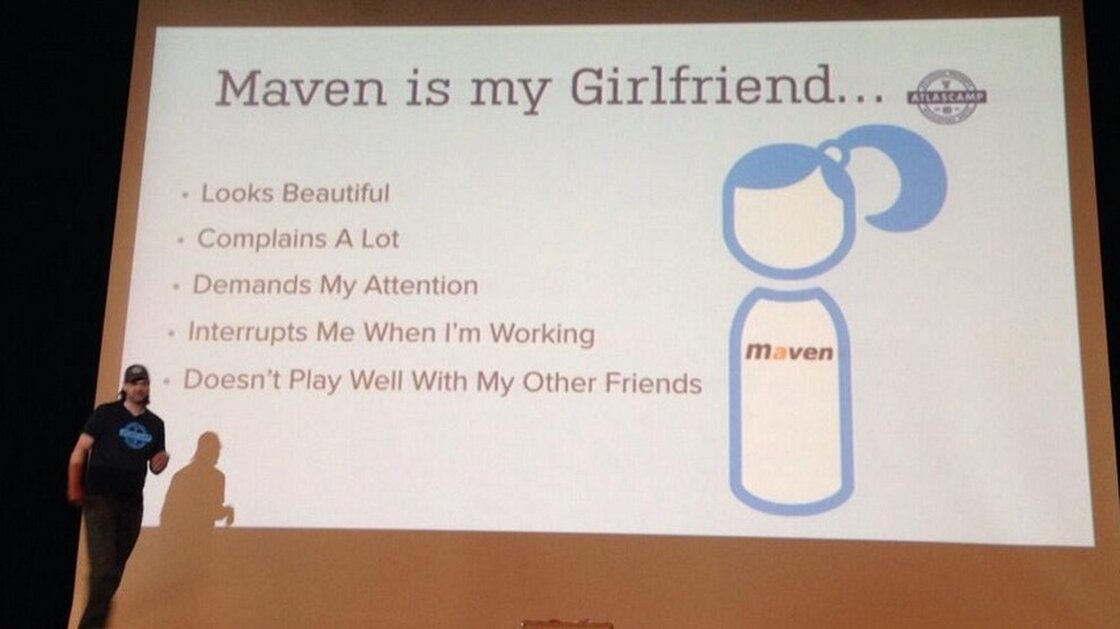 |
| You would have made the same point by comparing it to your fancy show dog. Or without any cutesy metaphors at all. |
Way to be classy and go for the low-hanging fruit of a joke there, Doklovic.
People who make jokes like this always baffle me: if your girlfriend is that much of a pain, or if your boyfriend is that much of an inept manchild, you're the one choosing to maintain a relationship with them. And if you think that every man or woman is going to behave in those ways, then please die alone without reproducing.
The jokes about women rustle my jimmies particularly (unsurprising, considering my ovary ownership), but I would be lying if I said I didn't die a little inside every time I see a pin like this on Pinterest:
 |
| Haha, it's funny because women are nagging harpies and men are clueless oafs! |
I appreciate Atlassian's response to this and their stated commitment to doing better as a group. They haven't outlined exactly how they plan to help Doklovic see the goof-up; I assume he has enough empathy and insight to realize just from this blowback alone why a joke about girlfriends being nothing more than pretty bimbos who keep men from getting stuff done was juvenile and inappropriate for an official presentation in a formal tech conference.
Wednesday, June 4, 2014
Pinterest Post: Punjammies and International Princess Project
Usually on Wednesdays (or every other Wednesday) I do a "What I('m) Read(ing)" post, and I do have one book I'm reading (Tropic of Cancer) and one book I just finished (White Teeth) that I want to talk about, but right now my blogging time is somewhat limited as I play hostess to a visiting friend. So, instead, a quick word about a package I just got!
When I packed for Stockholm, I brought one pair of winter pajama bottoms (warm, fleecy) and two pairs of all-purpose, year-round pajama bottoms (jersey knit bottoms from Target). One of the bottoms dated back to my junior year of college and so after many years of faithful service, had to be sent to the rubbish bin. Not to the donation bin; they were well beyond donating.
In a nutshell: I was in the market for some lounge-around-the-house wear.
Then I remembered a great website I had found via Pinterest: Punjammies.
I had wanted a pair since I first saw the pin (and first realized they had items that would even fit me), but put it off because I didn't need any at the time. I ordered a pair the same day I had to retire my tan capri coulettes. I got a pair like this, only without the border on the bottom:
When I packed for Stockholm, I brought one pair of winter pajama bottoms (warm, fleecy) and two pairs of all-purpose, year-round pajama bottoms (jersey knit bottoms from Target). One of the bottoms dated back to my junior year of college and so after many years of faithful service, had to be sent to the rubbish bin. Not to the donation bin; they were well beyond donating.
In a nutshell: I was in the market for some lounge-around-the-house wear.
Then I remembered a great website I had found via Pinterest: Punjammies.
I had wanted a pair since I first saw the pin (and first realized they had items that would even fit me), but put it off because I didn't need any at the time. I ordered a pair the same day I had to retire my tan capri coulettes. I got a pair like this, only without the border on the bottom:
 |
| Aamani Punjammies |
They are comfy, lightweight and fit wonderfully (a miracle for someone with my hips), though they are regular cotton instead of the stretchy jersey knit I've grown accustomed to. Anyway, the point of this post isn't that these are spectacular loungewear, even though they are. The point is that the proceeds go to the International Princess Project, a group in India that seeks to end human trafficking and provides former sex workers with a new trade (sewing), the chance to use it to earn a fair wage, and the environment needed to heal, mentally and physically, from their experiences.
 |
| Priya Punjammies |
Sunday, June 1, 2014
Armchair BEA Days 5 and 6: YA, Wrap-Up
I skipped the topic of choice because I am a bit short on blogging time at the moment. On Friday I picked up a friend of mine at the airport and we have been busy catching up and sight-seeing here in Stockholm. Naturally I think it is poor form to shut myself up in the kitchen and blog while I have a visitor so I've missed the last couple days (and will have to keep it short and sweet). And since a topic didn't even present itself to me right away, I take that to mean I don't have a burning desire to talk about anything that's already been covered (diversity is my ~thang~ but we touched on that earlier).
Our final genre of discussion is one that we know is a popular one these days: books for the younger crowd, from middle grade to young adult. If you do not normally talk about this genre on your site, maybe you want to feature books that you remember impacting you during this stage in your life. If this is where you tend to gravitate, maybe you want to list your favorites, make recommendations based on genres, or feature some titles that you are excited to read coming later this year.
I'm of the firm belief that YA doesn't exist. You know how bookstores decide what is YA, nine out of ten times? If the protagonist is a (pre)teen or child. That's it. Maybe some places make some content considerations, such as for violence or sex or so on, but that's not the defining aspect.
"Easy" reading and "hard" reading certainly exist (along a spectrum), and "easy" reading is where I sort most everything that people call YA: Harry Potter, The Hunger Games, Twilight, John Green's entire oeuvre, etc. etc. And to be honest, most of the time I think they're crap.
(This includes Harry Potter. I am the only person on Earth writing about books who doesn't like Harry Potter. I positively loathe the series, as a matter of fact. I am a hater, and I am gonna hate.)
So which YA novels do I like?
There are, of course, books that are considered YA that I do like, even love. For example, right now I'm reading Sarah Maas's Throne of Glass series. I studied Creative Writing with her at college and admired her writing even then, so I'm glad to see her succeed at BEA and around the world.
Roofbeam Reader mentioned another series that has long gotten the short shrift: The Dark is Rising sequence. I love these books and have compulsively re-read them, especially the eponymous second volume, from elementary school up until adulthood. If you haven't read this series, you should. I don't think it's just nostalgia tinting my love of these books; they are really and legitimately great stories with great Arthurian/magical world-building.
I read a lot of other fantasy in middle school: I devoured every Brian Jacques novel in the school library, and bought some of my own, though I fell out of the series eventually. I don't think I'd ever buy the series to own for myself, but they are nonetheless a fond memory. The same goes for Tamora Pierce's series Protector of the Small and Song of the Lioness. They were the only series I read from Pierce, but she is a prolific and productive writer. The one-off A Plague of Sorcerers by Mary Frances Zambreno impressed me and did a lot to influence my own ideas about fantasy. I also enjoyed the few John Bellairs books I could find, most notably The House With a Clock In Its Walls.
Science fiction goes hand-in-hand with fantasy, of course. I was maybe 15 or 16 when I first read Neuromancer and my enthusiasm for William Gibson has never waned. Prior to him, I enjoyed the books of William Sleator, particularly Interstellar Pig.
Fantasy wasn't the only thing I read, though. I also enjoyed a good mystery, too. By middle grade I had outgrown my Boxcar Children, Encyclopedia Brown, and Nancy Drew books and traded them in for some Agatha Christie. Who is not considered YA but nonetheless was a staple of my childhood. The same goes for my dad's old copies of The Thinking Machine stories and The Boys' Book of Great Detective Stories. (Again, I conveniently ignored the "For Boys" imperative.)
The latter was especially interesting because it had mostly true detective stories and also the history of detective work. That's where I first learned about Alphonse Bertillon, the French criminologist who determined a way of identifying suspects by measuring their body parts: like height, around the head, wrist, feet, and so on. It wasn't a terrible method, as the odds are quite significantly stacked against two people having the same name and having similar facial features and having identical or even similar identifying measurements and ratios. In fact, Bertillon's system helped the authorities in France capture quite a number of repeat offenders, and it was soon used by police forces around the world.
But in a stroke of ultimate weirdness, when Americans booked and measured a man named Will West, there was a nearly identical William West already in prison. Identical measurements, identical ratios, and their facial features were even similar to each other. The only truly significant difference between them that anyone could spot at a glance was their fingerprints. That case (and the fact that it's easier to take fingerprints than measure lots of bobs and bits) was probably the biggest factor in the switch over to fingerprints.
The final author I want to mention here is Wendelin van Draanen. How I Survived Being a Girl and the first few books in her Sammy Keyes: Detective series were a lot of fun.
Our final genre of discussion is one that we know is a popular one these days: books for the younger crowd, from middle grade to young adult. If you do not normally talk about this genre on your site, maybe you want to feature books that you remember impacting you during this stage in your life. If this is where you tend to gravitate, maybe you want to list your favorites, make recommendations based on genres, or feature some titles that you are excited to read coming later this year.
I'm of the firm belief that YA doesn't exist. You know how bookstores decide what is YA, nine out of ten times? If the protagonist is a (pre)teen or child. That's it. Maybe some places make some content considerations, such as for violence or sex or so on, but that's not the defining aspect.
"Easy" reading and "hard" reading certainly exist (along a spectrum), and "easy" reading is where I sort most everything that people call YA: Harry Potter, The Hunger Games, Twilight, John Green's entire oeuvre, etc. etc. And to be honest, most of the time I think they're crap.
(This includes Harry Potter. I am the only person on Earth writing about books who doesn't like Harry Potter. I positively loathe the series, as a matter of fact. I am a hater, and I am gonna hate.)
So which YA novels do I like?
There are, of course, books that are considered YA that I do like, even love. For example, right now I'm reading Sarah Maas's Throne of Glass series. I studied Creative Writing with her at college and admired her writing even then, so I'm glad to see her succeed at BEA and around the world.
Roofbeam Reader mentioned another series that has long gotten the short shrift: The Dark is Rising sequence. I love these books and have compulsively re-read them, especially the eponymous second volume, from elementary school up until adulthood. If you haven't read this series, you should. I don't think it's just nostalgia tinting my love of these books; they are really and legitimately great stories with great Arthurian/magical world-building.
 |
| This is the closest I could find to my edition of the book. Same image, but less dorky font. The new covers they're printing now are butt ugly; I hope they don't permanently replace this one. |
 |
| Fortunately the library editions weren't from JUST FOR BOYS, but even if they were, I would have ignored that appellation. |
Science fiction goes hand-in-hand with fantasy, of course. I was maybe 15 or 16 when I first read Neuromancer and my enthusiasm for William Gibson has never waned. Prior to him, I enjoyed the books of William Sleator, particularly Interstellar Pig.
Fantasy wasn't the only thing I read, though. I also enjoyed a good mystery, too. By middle grade I had outgrown my Boxcar Children, Encyclopedia Brown, and Nancy Drew books and traded them in for some Agatha Christie. Who is not considered YA but nonetheless was a staple of my childhood. The same goes for my dad's old copies of The Thinking Machine stories and The Boys' Book of Great Detective Stories. (Again, I conveniently ignored the "For Boys" imperative.)
The latter was especially interesting because it had mostly true detective stories and also the history of detective work. That's where I first learned about Alphonse Bertillon, the French criminologist who determined a way of identifying suspects by measuring their body parts: like height, around the head, wrist, feet, and so on. It wasn't a terrible method, as the odds are quite significantly stacked against two people having the same name and having similar facial features and having identical or even similar identifying measurements and ratios. In fact, Bertillon's system helped the authorities in France capture quite a number of repeat offenders, and it was soon used by police forces around the world.
But in a stroke of ultimate weirdness, when Americans booked and measured a man named Will West, there was a nearly identical William West already in prison. Identical measurements, identical ratios, and their facial features were even similar to each other. The only truly significant difference between them that anyone could spot at a glance was their fingerprints. That case (and the fact that it's easier to take fingerprints than measure lots of bobs and bits) was probably the biggest factor in the switch over to fingerprints.
The final author I want to mention here is Wendelin van Draanen. How I Survived Being a Girl and the first few books in her Sammy Keyes: Detective series were a lot of fun.
In the meantime, we want to know how you felt the week went. What were some of your favorite aspects of Armchair BEA 2014? What were the most intriguing conversations or the posts you recommend everyone read? Did you want to summarize your own posts all in one spot? This is your opportunity to share your wrap-up for the week in the way you feel most appropriate.
On Day 2 I had a really fun and interesting conversation about book reviews on Good Reads and why I'm not going to read The Fault in Our Stars. That and finding all these new, interesting blogs to read has been the best part.
If you go back through my posts (beyond ArmchairBEA), you'll notice I have eclectic, though generally thematically connected, tastes and posts on topics that, for whatever reason, I can't find a whole lot of active-but-small blogs posting on. I'm not a Christian, I'm not a wife, and I'm not a mom, so the typical ~blogging~ community is generally on a different wavelength from me. But this week it's felt a little like I have found my people, so to speak. I hope those of you who have found my ArmchairBEA posts worth reading and commenting on will stick around for the long haul and future posts that have nothing to do with books!
Subscribe to:
Posts (Atom)








